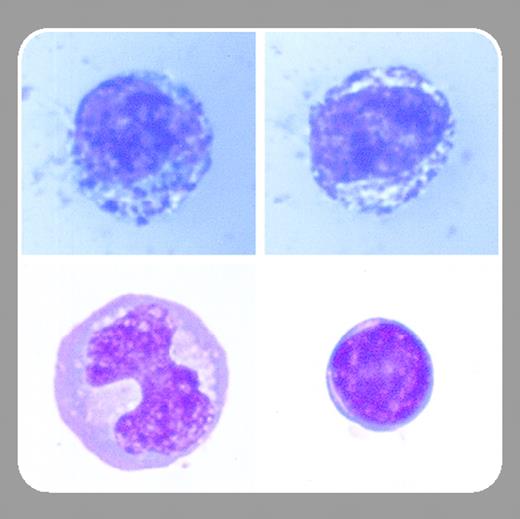Models that accurately predict in vivo human hematopoiesis have long been sought by investigators studying the biology of hematopoietic stem cells (HSCs) and their clinical applications. However, the in vitro assays available clearly do not recapitulate true HSC function, and murine in vivo assays have proven poorly predictive of human hematopoiesis in many regards. Since the first description of mouse xenograft models, in which the functional activity of primitive human hematopoietic cells is assayed in immunodeficient mice, these approaches have been extensively used to study putative human stem cell behavior. But correlative studies defining the human cell populating engrafting in these mice versus those that behave as true HSCs in humans have not been performed to date.
In this issue of Blood, Horn and colleagues (page 4329) describe the results of the first study to directly compare the activity of primate repopulating cells both in a nonobese diabetic/severe combined immunodeficiency (NOD/SCID) model and concurrently in an autologous baboon recipient. In an elegant series of experiments, both NOD/SCID mice and autologous baboons received transplants of the same populations of retrovirally transduced granulocyte colony-stimulating factor/stem cell factor (G-CSF/SCF)-primed baboon bone marrow-derived CD34+ cells in parallel, and their contributions to hematopoiesis in the 2 species were compared. Through the use of retroviral marking, the investigators were able to track not only baboon cell engraftment but also engraftment by genetically modified baboon cells and, using state-of-the-art technology, to compare individual clones derived from the same transduced starting population of cells engrafted in the 2 species. While the overall percentage of engrafted baboon cells expressing the marker gene in the xenografted NOD/SCID mice was similar to that observed early after transplantation in the autologous baboons (around 50% vs up to 39%, respectively), a fall to more moderate, stable levels (around 5%) occurred after 8 to 12 weeks in the baboons, suggesting that the NOD/SCID assay primarily reads out engraftment by shorter-term progenitor cells as opposed to true long-term HSCs. To extend their observations, Horn and colleagues employed linear amplification mediated-polymerase chain reaction (LAM-PCR), a powerful technique that allows the simultaneous amplification of retroviral integration sites that serve as clonal tags for transduced cell progeny. Several unique integration sites were confirmed among both the NOD/SCID and baboon samples, yet clones found in the NOD/SCID mice were found only early after transplantation in the baboon, providing further evidence in support of the researchers' conclusions.
However, the NOD/SCID model provides information both on the level of overall engrafting activity present in the test population, as well as the transduction efficiency, compared with the baboon and other large-animal models. In large animals, engraftment by transduced cells is the only possible readout, with no ability to distinguish endogenous recovery (likely even after 1020 cGY) from activity of infused nontransduced cells. It is thus possible that the fall in the percentage of transduced cells in the baboon actually represents endogenous recovery competing with the infused graft. In addition, though the insertion site analysis provides support for the existence of 2 distinct populations of engrafting cells, it is possible that the analysis may have favored this conclusion. That is, the detection of progeny of transduced cells that had undergone the multiple rounds of ex vivo division presumably required to generate sufficient numbers to be read out in both the NOD/SCID and the baboon, a scenario likely to result in the loss of long-term repopulating ability by such cells, might be favored.
A comparison of 2 vector systems within each baboon was also performed, and in this regard, the NOD/SCID model appeared predictive in that the ratio of engraftment observed in the primate was similar to that observed in the xenograft model. In addition, xenografting NOD/SCID mice with steady-state marrow collected from a baboon 18 months after autologous transplantation with genetically modified cells yielded similar results to those seen in the primary baboon recipient.
In any case, the marked discrepancy between NOD/SCID and baboon overall engraftment by genetically modified cells is important information that suggests limitations to this xenograft model as a predictor of true long-term human or primate HSC behavior. This commendable work provides a cautionary tale concerning the use of the xenograft NOD/SCID model as a sole surrogate assay for human HSCs, yet further development of this valuable and widely available model in parallel with large-animal studies should help to guide the appropriate use of both for developing human hematopoietic stem cells for clinical applications.



